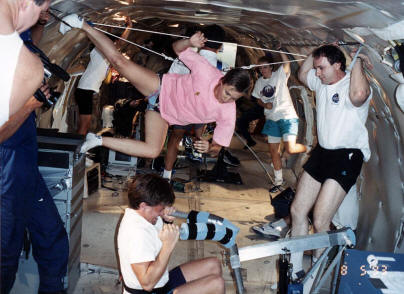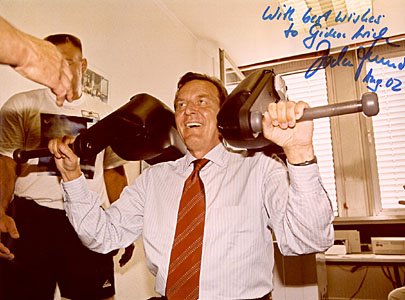|







| |
ACES - Ariel Computerized Exercise System
|
Computer
controlled machines for exercise diagnostics and rehabilitation.
Athletic training of the past has been unable to
reproduce real athletic movement at speeds comparable to
those achieved during competition sports. ACES' revolutionary mix of
computer-controlled resistance technology, custom-designed equipment and
professional expertise has changed athletic training
forever
 . .
The ACES at
NASA flights (Click Here)

ACES trains muscles
to contract fast. The faster the muscles contract, the faster the limb
moves, the faster the limb moves, the faster a person can run, the
higher a person can jump, the harder they can hit, the further they
can throw. The better they can functionally perform ... - Dr.
Gideon Ariel, Ph.D.
Recent Comment from a User of the ACES:
Christopher Williams cwilliam@brockport.edu
cwilliam@brockport.edu
Gideon Ariel <gideon@arielnet.com>
date Wed, Oct 26, 2011 at 9:00 AM
subject
Hello from Brockport!
mailed-by brockport.edu
Hi Gideon,
I hope this email finds you well.
I thought I would touch base with to update you on our progress
in the Biomechanics Lab.
And, I wanted to ask you a couple of questions.
We are currently power training more than 50
athletes in over 29 weekly training sessions on the ACES in the lab from
the hockey, volleyball, swim, and track teams!
Each team has their own selected exercises, which are coordinated
with our strength and conditioning coaches and their team coaches.
For example, hockey and track trains specifically for sprint
speed; volleyball trains for vertical jump; and swimmers train for their
individual strokes. We have
created several exercises designed to mimic the movement and velocity
patterns seen for selected sport-specific skills.
And we use video analysis to examine individual patterns of
movement.
Our assessments include speed sets on the ACES to
measure maximal velocity on each exercise.
In addition, we perform force-velocity profiles using speeds of
10, 40, 70, 100, 130, and 160 degrees per second (we have never recorded
a speed greater than 155 deg/s on any exercise with the ACES).
Finally, we always have a "real-world" assessment, such as sprint
times on the ice, in the pool, or on the track; and vertical jump and
long jump.
Using data from our speed sets, each individual
athlete trains at a velocity determined by their own capabilities, and
over a range of motion specific to their body structure.
To set velocity-based intensities for each exercise, we have been
using 50% (and less) of max for off-season conditioning, 75% of max for
pre-season, and 100% of max for in-season.
These values are analogous to traditional load-based training,
but are relatively arbitrary since there is no specific literature to
guide us.
Range of motion on the ACES is standardized by
determining desired starting and ending positions (i.e., physiological
range of motion) of selected joints for each exercise.
In addition, range of motion is adjusted during early training
sessions to maximize and the potential load range.
We have been modifying range of motion using the position-time
graphs, and this has been very effective.
As you probably know, the Philadelphia Flyers now
have an ACES, and they have begun to train their players.
Myself and one of my students visited their training facility
when the ACES arrived, and we discussed the things we do in our lab, and
trained them to perform similar measures.
Now that they have cut to their final roster, they have indicated
they will send me their data, and we will share our results with them.
Their head trainer is Jimmy McCrossin, and he appears to be
genuinely interested in the science behind multi-joint isokinetic
training. So I am
(obviously) hopeful that this relationship will continue to grow.
I am currently finishing papers on our training of
the volleyball and hockey teams from the spring, and a case-study on a
swimmer from spring-summer.
I also have an extensive set of notes for a review paper of multi-joint
isokinetic training. As you
know, there is little literature out there, except for perhaps the
articles from Weiss.
However, almost none of that is actual training studies.
Take care of yourself, and we'll talk soon.
Chris
Christopher D. Williams, Ph.D.
Associate Professor, Biomechanics Lab Director
Department of Kinesiology, Sport Studies, &
Physical Education
The College at Brockport, State University of New
York
Brockport, New York
14420
Office: 585-395-5252
Biomechanics Lab: 585-395-2621
Fax: 585-395-2771
E-mail: cwilliam@brockport.edu
www.brockport.edu/pes/faculty/williams.html
Watch exercise machine video [ 256k
broadband | 56k
modem ].
|
|
  |
|
  |

German Chancellor Gerhard Schrder
testing his limits on ACES... |
|
Watch exercise machine video [ 256k
broadband | 56k
modem ].
The revolutionary Ariel
Computerized Exercise System (ACES) heralds a new era in physical
conditioning, executive fitness, sports training, rehabilitation and
research. The personal computer approach to the practice of resistive
exercise is a quantum change in both thinking and application. The
computer puts resistive exercises into a broad new realm of
possibilities for applications in health care, human service, athletics,
fitness, training and education. A few impressions of the ACES
software:
Check here
 for ACES product information, or contact
for ACES product information, or contact
 us
directly. us
directly.
|

On Fri, Nov 5, 2010 at 6:24 AM, Christopher Williams <cwilliam@brockport.edu>
wrote:
Hi Gideon,
I hope all is well with you and Ann, and I wanted to extend a delayed welcome
back from your trip. I hope you didn’t cause any “trouble”.
As you know, the ACES Multifunction Machine is here at Brockport, and its
running very well. There has been a lot of excitement generated here since its
arrival. I have been promoting the cutting-edge technology to my colleagues,
students, and athletes, and have explained how the Multifunction Machine allows
for methods of training that cannot be done with any other machine. In addition
to me using the machine almost every day, I have several students using the
machine for a variety of projects.
For example, I have a thesis student who is using the ACES machine in a study
designed to investigate the effect of training on the elastic properties of
tendons (a topic related to my own dissertation). The training protocol will be
plyometric in nature – in fact, I’ve named it a “variable-velocity isokinetic
plyometric training program!” I’m using this as a launching pad to examine the
effectiveness of various training programs, particularly variable-velocity
programs, on muscle power over a long-term timeline.
I have another student who is using the machine to examine EMG patterns during a
straight-leg deadlift for flexible and non-flexible individuals. As part of our
preparation, we are building a box-platform that will house two AMTI force
platforms, on which participants will stand. When the box is completed, we will
be able to measure individual ground reaction forces from each foot during
deadlifts, squats, and anything else we can think of. Using the ground reaction
force data and the force and power data from the ACES machine, I expect to be
able to look at the transfer of force along the entire kinematic chain. I’m not
exactly sure what to expect, but it sounds like fun!
I have organized a research-team of 7 exercise physiology students to begin to
train Brockport athletes on the ACES machine next spring. In coordination with
team coaches and our strength and conditioning coaches, we intend to train
selected athletes from track, volleyball, football, wrestling, and hockey. I
asked each coach to identify athletes based on their enthusiasm for their sport
and their goals to pursue higher levels of competition, so we should have a
highly motivated group. The research-team will initially be introduced to
concepts related to force-velocity-power relationships, isokinetic training, and
(variable) velocity patterns of sport-specific skills. Athletes will schedule
training sessions in the Biomechanics Lab, where team members will administer a
user/sport-specific training protocol. Toward the end of the semester, the
research-team will measure and discuss pre-post results, with a goal to submit
results for publication.
At this time, I am looking for any standardized protocols to measure muscle
power, which I intend to include as a pre-post measure. In addition, I am
looking for any sport-specific training protocols that I may be able to use, and
in which I may be able to integrate the variable velocity capabilities of the
ACES machine. I have reviewed many articles to date, but I would certainly
welcome any thoughts or suggestions you may have. I did look for articles
related to volleyball training, including on the APAS website, but was unable to
find any detailed training protocols. If you would be willing to share some of
the training procedures or stories you have with the Olympic volleyball team, it
would much appreciated.
I am hoping to maintain a team of students to continue training our athletes
every semester for the foreseeable future, so I will continue to expand my range
of sports and athletes included in the program. My next targets are athletes and
companies outside of Brockport, with which I have had some preliminary
conversations. At the moment, my only concern is being able to accommodate the
number of students and athletes that have expressed an interest!
Arti has suggested to me that you may be interested in coming to Brockport to
speak about your experiences and the ACES machine. Please consider this an open
invitation. Although it may be difficult for the college to pay you for your
visit, I have already secured travel and room-and-board expenses in anticipation
of the possibility.
Well, I know this email is rather long, but I thought I’d update you on the ACES
machine here at Brockport. It has generated a lot of excitement. Also, I wanted
to thank you again for your hospitality over the summer. Whenever possible, I
put my colleagues through the same speed pyramid set (20 reps) that you had me
try!
Please send my regards to Ann. Take care,
Chris
Christopher D. Williams, Ph.D.
Associate Professor, Biomechanics Lab Director
Department of Kinesiology, Sport Studies, & Physical Education
The College at Brockport, State University of New York
Brockport, New York 14420
Office: 585-395-5252
Biomechanics Lab: 585-395-2621
Fax: 585-395-2771
E-mail: cwilliam@brockport.edu
www.brockport.edu/pes/faculty/williams.html
|
